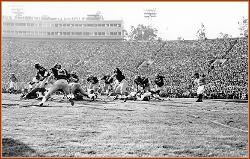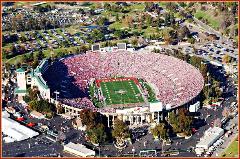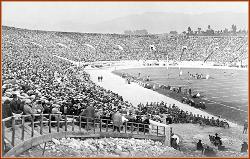



Strahov Stadium
The Strahov Stadium (Strahovský stadion in Czech) is a stadium in the Strahov district
of Prague, Czech Republic. It is the second largest stadium in the world after the
Indianapolis Motor Speedway, seating nearly 360,000. Construction began on a
wooden stadium in 1926, and was replaced by cement grandstands in 1932. Further
construction occurred in 1948 and 1975. The playing field, surrounded by seating on
all sides, is 63,500 square metres. Contemporarily the stadium serves to Sparta
Prague as a training centre with 8 football pitches (6 pitches of standard sizes and 2
futsal pitches). The original stadium dates to the First Republic between the World
Wars and served as a venue for Sokol displays of synchronized gymnastics on a
massive scale. It was later used for large displays during the communist era.
Performances with several hundreds of gymnasts making various complex formations
and exercising identically while accompanied by tunes from traditional folk music
attracted attention of many visitors. Each time, among the widely popular shows were
those of young well-trained recruits who wore only boxer shorts while on the display or
women dancing in miniskirts... The groups of gymnasts (unlike the soldiers who were
ordered to practise and participate) were put together from keen local Sokol atletic
association members who regurarly trained for the show throughout the year prior the
event, which repeated every five years. The ambiguous name of the performance,
Spartakiáda, referred to quondam power and strength of once uprising slaves led by
Spartacus. In the last decade several studies have looked at adaptive reuse and
preservation of this unique structure. The stadium is sited on a prominent hill
overlooking the old city. It can be accessed by taking the funicular up the hill through
the gardens.
Motor racing took place in the stadium in the mid-1960s.
On August 18, 1990, Strahov Stadium housed a Rolling Stones concert with more than
150,000 people in attendance, including Václav Havel.


Future of the Stadium
Over the years, the Czech soccer association's (CMFS) efforts to convince Prague city councilors to replace the crumbling stadium in Strahov,
Prague 6, have met a stiff defense. However, with an assist from the Czech national team's recent Euro 2004 soccer championships
qualification and the ensuing nationwide jubilation, association officials have finally netted a goal.
Thanks to a hefty dose of Euro-fever, on Nov. 13, not long after the national team clinched its berth in the continent's biggest sporting event -
and spurred by the hopes of one day hosting its own Euro championship - the city approved a proposal to build a recreational and commercial
megacomplex on the site where both Strahov and neighboring Evzen Rosicky stadiums stand. While the details are still being discussed, the
initial plans are to build a state-of-the-art 52,000-seat national stadium on Evzen Rosicky Stadium-occupied land, and to convert the mammoth
Strahov stadium complex into a commercial zone complete with hotels, restaurants and shops.
The proposal, engineered by soccer association president Jan Obst, stipulates that private investors will fund the new stadium's 4.5 billion Kc
($167 million) price tag. The state will contribute about 1 billion Kc from an already established sports grant, as well all of the land.
Since the announcement, city and CMFS officials have been reluctant to reveal any additional details about the stadium's financing or its
eventual construction, saying nothing is certain until the preliminary agreement is signed later this year, according to CMFS spokesman Daniel
Macho. Indeed, most of the talk surrounding the new stadium has centered on one issue: the Czech Republic's chances of landing the
European championship.
"We are thinking positively [about getting the tournament]," said a cautious but optimistic Jaroslav Vacek, CMFS vice president.
Other officials have an even more ambitious outlook. Prague city councilor Pavel Klega, the main contact between City Hall and CMFS,
predicted that the new complex could be the first step toward an eventual Olympic bid.
But if the Czech Republic is serious about landing a major sporting event anytime soon, it's going to need at least one more large 50,000-plus
stadium and a couple of smaller 30,000-seaters, as well as some major infrastructure work to support the accompanying influx of fans and
media, Klega said.








